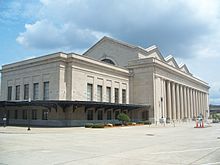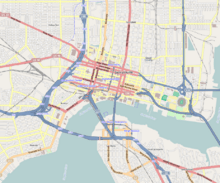LaVilla facts for kids
Quick facts for kids
LaVilla
|
|
|---|---|

Prime F. Osborn III Convention Center located in the southwest corner of LaVilla
|
|
| Area | |
| • Total | 1.00 km2 (0.385 sq mi) |
| • Land | 1.00 km2 (0.385 sq mi) |
| Population
(2008)
|
|
| • Total | 185 |
| • Density | 185.5/km2 (480.5/sq mi) |
| ZIP Code |
32202
|
| Area code(s) | 904 |
LaVilla is a really old and important neighborhood in Jacksonville, Florida. It used to be its own town! After the American Civil War, it grew into a special place. In 1887, it became part of Jacksonville and is now considered part of downtown.
LaVilla was once known as "the heart of African American culture" in Florida. Even today, it's mostly an African-American neighborhood. You can find historic buildings like the Ritz Theatre, the Richmond Hotel, and the Clara White Mission there. Many of these buildings are listed as important historical sites. LaVilla also became a big center for trains and making cigars.
Contents
Where is LaVilla Located?
LaVilla is in the northwest part of downtown Jacksonville. It's bordered by State Street to the north, I-95 to the west, Broad Street to the east, and Brooklyn to the south.
A Look at LaVilla's Past
How LaVilla Started
Back in 1801, when Florida was still Spanish territory, a colonist named John Jones received a large piece of land here. This land eventually became LaVilla.
From Town to Neighborhood
LaVilla grew as a small town next to Jacksonville. During the American Civil War, when Union soldiers controlled parts of Florida, LaVilla was home to many Union troops. Many enslaved people found freedom here under the Emancipation Proclamation of 1863. After the war, more freed people moved to LaVilla, and it officially became its own town.
Most of the people living in LaVilla were Black. During the Reconstruction era, many Black citizens were elected to important government jobs in LaVilla, even as mayor! But in 1887, LaVilla and five other nearby towns joined the city of Jacksonville. It then became a neighborhood within the city. Later, new state laws made it very hard for African Americans to vote, which stopped them from being involved in politics.
A Center for Culture and Transportation
For many years, the northern part of LaVilla was a lively hub for African American life and culture in Jacksonville. The southern part of the neighborhood became a major railroad center in the late 1800s. Several train lines met at Union Station, which is now the Prime F. Osborn III Convention Center.
LaVilla was mostly saved from the Great Fire of 1901, which destroyed much of downtown Jacksonville. In the early 1900s, LaVilla was a very important place for African-American culture. There was a fantastic music and entertainment scene. Many famous jazz artists came to play at the Black clubs on and around Ashley Street. These clubs were separate from white clubs because of Jim Crow laws, which enforced racial segregation. In 1929, the Ritz Theatre opened. It became a key stop on the "Chitlin' Circuit" for Black entertainers and was LaVilla's main place for performances.

The area on Ashley Street, especially west of Broad Street, was so vibrant that people called it the "Harlem of the South." Famous spots included Nick’s Pool Parlor, the Frolic and Roosevelt theaters, and hotels like the Wynn/Egmont Hotel, which was known for hosting touring performers. There were also great places to eat like the Boston Chop House and Mama’s Restaurant, and popular hangouts like the Lenape Bar. The Ritz Theatre and The Knights of Pythias Hall hosted many famous artists.
Changes Over Time
After the 1960s, LaVilla started to decline. The railroad industry changed, and many jobs were lost. Also, building I-95 cut through and divided the neighborhood. When segregation ended in the mid-1960s, many residents moved to other areas for new homes and job opportunities.
In 1993, Mayor Ed Austin created the River City Renaissance plan. This plan put millions of dollars into fixing up and developing LaVilla. Old buildings were torn down, and important historical places like the Ritz Theatre were restored. Now, LaVilla also focuses on heritage tourism, inviting people to learn about its rich history.
Getting Around LaVilla
LaVilla has good transportation options. The Jacksonville Transportation Authority has a free Jacksonville Skyway system, which is an automated people mover. There's also a big bus network.
Skyway Stations in LaVilla
- Jefferson: Located at Jefferson Street and Bay Street, this station serves the Federal Reserve Building and Courthouse.
- Convention Center: On Bay Street, this station serves the Prime F. Osborn III Convention Center.
Cool Places and Features

Places like the Ritz Theatre were important venues for Black entertainers and audiences. Today, the theater still hosts shows and helps visitors learn about Black history.
The Jacksonville office of the Federal Reserve Bank of Atlanta is located on Water Street, at the southern edge of LaVilla.
LaVilla School of the Arts is a popular middle school in Duval County. It continues the tradition of performance and art that was so important in the Ritz/LaVilla area. Ritz Voices is a youth choir with 100 members in the neighborhood.
The Clara White Mission is also in LaVilla, located in what used to be the Globe Theatre.
Mayors of LaVilla (Before it Joined Jacksonville)
- Francis F. L’Engle (1866)
- Mitchell P. Chappelle (1874–1876)
- Alfred Grant (1876–1877), who also served as a councilman and state representative.
- In 1887, LaVilla became part of the City of Jacksonville.


